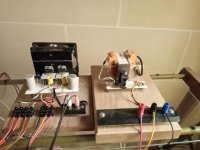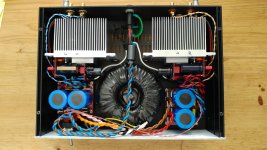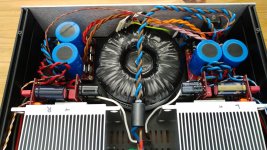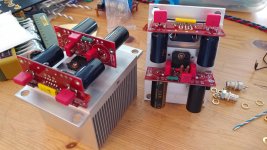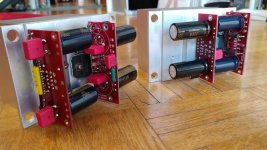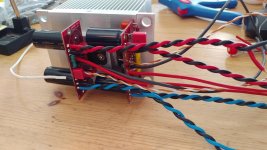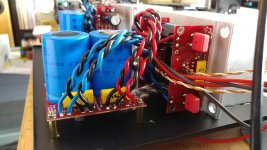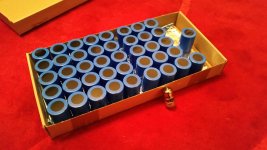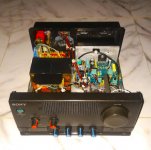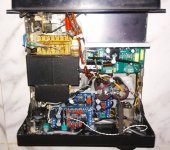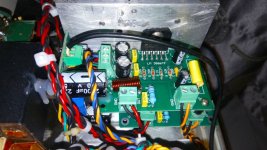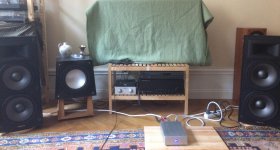This is an a chip amplifier that works with a heavily truncated expenditure. There are no luxury metal boxes used, no expensive toroidal transformers, no expensive eletrolytic capacitors but only the minimum of requirements.
The stereo amplifier is based on the chip LM3886. The sound is beautiful.
The stereo amplifier is based on the chip LM3886. The sound is beautiful.
Attachments
Hello Ed,
Fair play to you for showing that, it just goes to show that all the 'bells and whistles' are really not needed. It's also very easy to alter anything in a few minutes.
I do the same myself.
Cheers and all the best
Fair play to you for showing that, it just goes to show that all the 'bells and whistles' are really not needed. It's also very easy to alter anything in a few minutes.
I do the same myself.
Cheers and all the best
Therir results are showing that was a big mistake now too.Look at his flag. They never locked down.
This is a four channel gainclone I've built to power my two-way transmission line speakers on hot summer days when Class A is too much heat. I have an active line level crossover, so the GC will directly drive the woofers and tweeters (the tweeter has a 68uF cap in series though).
This build features a 400VA transformer with four 18VAC secondaries and two separate PSUs for the left and right channels. The PSUs each have two 33000uF 25V filter caps. Each side has an LM4780 and an LM3886 chip for woofer and tweeter duty.
The heatsinks are from an old Pentium processor and the fin spacing matches up with the spacing of the vents in the bottom and top plate of the case, quite a coincidence.
I really like how the internal wiring turned out in this build.
This build features a 400VA transformer with four 18VAC secondaries and two separate PSUs for the left and right channels. The PSUs each have two 33000uF 25V filter caps. Each side has an LM4780 and an LM3886 chip for woofer and tweeter duty.
The heatsinks are from an old Pentium processor and the fin spacing matches up with the spacing of the vents in the bottom and top plate of the case, quite a coincidence.
I really like how the internal wiring turned out in this build.
Attachments
Hello Dave,
Great build, I was going to ask where you got those huge heat sinks, then I saw they are computer ones, my goodness, some computer.!! 🙂
Cheers
Great build, I was going to ask where you got those huge heat sinks, then I saw they are computer ones, my goodness, some computer.!! 🙂
Cheers
Yeah, I found them at a bulky waste collection center, someone was throwing out their old PC so I snagged them up.
Notice that the LM3886 has smaller Panasonic FR caps installed in the final build, I had to pull the taller Nichicon I had installed before (see pics below) or the transformer wouldn't fit.
Looking back at the pics this was a challenging build, so little space, so much wiring to do.
Notice that the LM3886 has smaller Panasonic FR caps installed in the final build, I had to pull the taller Nichicon I had installed before (see pics below) or the transformer wouldn't fit.
Looking back at the pics this was a challenging build, so little space, so much wiring to do.
Attachments
Hi Rodeodave
Excellent build!! congratulations!!!
housing is from modushop?
As i see you are in the alps...so no chance to meet you and your builds😉🙂
question:
you wrote 18VAC secondary and your caps PSU caps (vishay 33000) are 25V- is this not too closed? i got at my 120VA transformer under normal use 27,1V and with little load/playing 25,6 or so...
thx
chris
Excellent build!! congratulations!!!
housing is from modushop?
As i see you are in the alps...so no chance to meet you and your builds😉🙂
question:
you wrote 18VAC secondary and your caps PSU caps (vishay 33000) are 25V- is this not too closed? i got at my 120VA transformer under normal use 27,1V and with little load/playing 25,6 or so...
thx
chris
Last edited:
The housing is from modushop, yes, I bought it right at the factory when we were visiting Bologna. They're really nice people.
Nominally, an 18V secondary with a MUR860 full wave rectifier (1V Vf) would give 18*2^.5-2=23.5V. Actual measured voltage after rectification is 23.3V. I've been running several amps with 18V secondaries with these caps for years now (mostly First Watt or Pass designs), no problems so far. Neuhold Elektronik used to stock them and I got a whole pallet.
Nominally, an 18V secondary with a MUR860 full wave rectifier (1V Vf) would give 18*2^.5-2=23.5V. Actual measured voltage after rectification is 23.3V. I've been running several amps with 18V secondaries with these caps for years now (mostly First Watt or Pass designs), no problems so far. Neuhold Elektronik used to stock them and I got a whole pallet.
Attachments
G'day Boys,
May I present a crude looking boombox with some fancy internals.
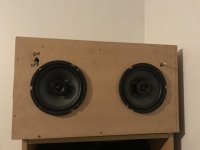
It is still in the prototype phase as I am yet to decide on how to appropriately deal with the speakers. Right now its using some generic ceiling speakers bought on clearance from a local retailer.
Guts wise, we got some goodies.
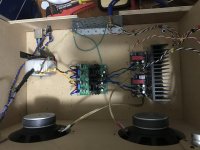
The amp boards are LM1875 boards that I call 'The Big Cap' . They are a home brew board of based off of the original Schoolies amp we all know and love.
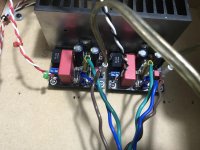
I never liked the ebay boards as their too small and lack the fuse rails of the original.
I also wanted to try using a 22uf film cap in place of the usual bipolar electrolytic in the feedback network. Hence the name because that 22uf film cap is pretty hilarious.
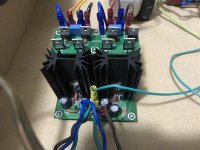
The power supply is my home-brew version of Carlos' famous dual LM338 snubberised regulated PSU as found on decibel dungeon.
May I present a crude looking boombox with some fancy internals.

It is still in the prototype phase as I am yet to decide on how to appropriately deal with the speakers. Right now its using some generic ceiling speakers bought on clearance from a local retailer.
Guts wise, we got some goodies.

The amp boards are LM1875 boards that I call 'The Big Cap' . They are a home brew board of based off of the original Schoolies amp we all know and love.

I never liked the ebay boards as their too small and lack the fuse rails of the original.
I also wanted to try using a 22uf film cap in place of the usual bipolar electrolytic in the feedback network. Hence the name because that 22uf film cap is pretty hilarious.

The power supply is my home-brew version of Carlos' famous dual LM338 snubberised regulated PSU as found on decibel dungeon.
Hello SF,
Nice idea to make a BoomBox and you've made the amplifier superbly.
Good partners for the LM1875 are the Visaton FR10 or the FRS8 both have good reputations for use in all sorts of enclosures.
Cheers
Nice idea to make a BoomBox and you've made the amplifier superbly.
Good partners for the LM1875 are the Visaton FR10 or the FRS8 both have good reputations for use in all sorts of enclosures.
Cheers
nice sadface
i remember your big cap board.😉
The heat sink of your rectifier diodes looks very massive...which one are these?
chris
i remember your big cap board.😉
The heat sink of your rectifier diodes looks very massive...which one are these?
chris
G'day Chermann,
I built the bugger back in January. It simply took me this long to plug it in!
The heatsinks are for the LM338 regs.
They are an Aavid Thermalloy 530002B02500G
https://nz.element14.com/aavid-thermalloy/530002b02500g/heat-sink-2-6k-w-to-220/dp/2295719
They were the biggest pcb mount heatsinks I could find with a standard footprint.
The issue with the speaker side is trying to get the most bass out of the smallest box with a smallish FR. More research required....
I built the bugger back in January. It simply took me this long to plug it in!
The heatsinks are for the LM338 regs.
They are an Aavid Thermalloy 530002B02500G
https://nz.element14.com/aavid-thermalloy/530002b02500g/heat-sink-2-6k-w-to-220/dp/2295719
They were the biggest pcb mount heatsinks I could find with a standard footprint.
The issue with the speaker side is trying to get the most bass out of the smallest box with a smallish FR. More research required....
First ever completed build! (Others are in the works..)
I offer no nudes since the choice of enclosure was stupid and it was hell to put it together (Even though it's pretty imo). But it's a Folsom DIY7297 with a 21v smps. Sounds beautiful and offered a lot of learning. Especially soldering in tight spaces with wires running everywhere..


I offer no nudes since the choice of enclosure was stupid and it was hell to put it together (Even though it's pretty imo). But it's a Folsom DIY7297 with a 21v smps. Sounds beautiful and offered a lot of learning. Especially soldering in tight spaces with wires running everywhere..



Attachments
Well that's just mean!
I want to see how you managed to stuff a useful amp into that tiny little box.
It must have been quite a feat.
I want to see how you managed to stuff a useful amp into that tiny little box.
It must have been quite a feat.
- Home
- Amplifiers
- Chip Amps
- Chip Amp Photo Gallery
